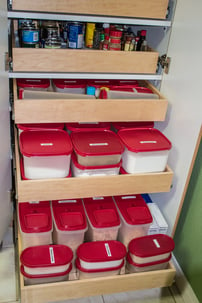

The balance between metadata structure and flexibility
Our house outside of Atlanta has no formal pantry – we only have a shelving unit (see photo bellow) that sits between the dining and kitchen areas. When we were organizing it, we weren’t thinking of schemas, we were thinking about grouping things together logically: which things get used in combination, which things get used the most frequently v. the least frequently; which things are awkward sizes and therefore need special spacing; which things are loose or flexible. What resulted was more ontology than taxonomy. Everything is grouped by relationships or accommodations, rather than strict hierarchy.
Sara James, Senior Marketing Technology Consultant
.png?width=192&name=MicrosoftTeams-image%20(6).png)
A pantry is a great visualization of how we organize assets. What do we have, who needs to use them, what is the purpose of storing them, and how frequently will they be used? In our pantry here, all of the baking goods are grouped together, so I don’t have to go hunting when I bake snickerdoodles. All of the pancake mixes and syrups are grouped together, right by the edge, because those supplies are awkward in size, but used every weekend.
When I’m designing taxonomies and metadata schemas for a CMS, DAM, or any part of a content ecosystem, I’m really focused on purpose and reuse. Who is going to use the taxonomy – both for storage and retrieval of assets? How knowledgeable are they about these items? Can we simplify the organization for clarity without losing specificity?
I also care about why we are storing – is this for reuse? If so, who is reusing it and how frequently? If it is just for a backup, that taxonomy might be more rigid and less user-friendly, because it will be mostly used by librarians and system admins.
There is no ‘one right way’ to design a taxonomy. Like all tools, it has to serve a purpose, and serve the people who use it, rather than the people being a slave to it. Organization is all about the ability to find something when you need it, so however you build it, it needs to make sense to the users.

Could my pantry be improved? Absolutely. There are tons of examples online of amazingly constructed and organized pantries.
But for us, this is too rigid, too hard to maintain, and doesn’t meet our daily needs. It always goes back to purpose: what content is getting stored, for whom, and how formal / structured does it need to be, does it need to be very accessible, or very closed off?
So if you are embarking on building a taxonomy, or a pantry, here are some preliminary steps.
- Talk to the people who will use the repository – why do they need the new organizational schema? What isn’t working for them today?
- Look at any existing organizational schema. Is there a lot of chaos? Is it logical? Check with users about where they have challenges in the current system.
- Really think about the purpose. Who is this for? What are you storing? Is this for re-use, or for backup?
- Do a design prototype and share with your users. Make sure it works for them before you actually build out the whole system.
Armed with that process, you can build a solid taxonomy that will serve your coworkers (or family) well.
By Sara James, Senior Marketing Technology Consultant
Here are the topics and the ICP experts blog series weighing in:
1: Getting stakeholder buy-in to a winning plan: Victor Lebon, CEO, EMEA & APAC
2: Plan beyond the tech; Adopting and Adapting: Jing Wang, Consultant
3: Think ecosystem, not platforms: Tom Sloan, Director, Marketing Technology
4: Find the balance between metadata structure and flexibility: Sara James, Sr. Marketing Technology Consultant (this blog)
5: People and resources make a difference: Elliott Brown, Group Business Director

.png?length=800&name=Untitled-4-CrOps%20Maturity%20Assessment%20landing%20page%20graphic%20(1).png)


%E2%80%8B%20%E2%80%8B.png?length=256&name=Blue%20B__Implement-%20(Technology%20Implementation)%E2%80%8B%20%E2%80%8B.png)
%E2%80%8B%20%E2%80%8B.png?length=256&name=__Implement-%20(Technology%20Implementation)%E2%80%8B%20%E2%80%8B.png)
%E2%80%8B.png?length=256&name=Blue%20B__Adopt-%20(Technology%20Adoption)%E2%80%8B.png)
%E2%80%8B.png?length=256&name=__Adopt-%20(Technology%20Adoption)%E2%80%8B.png)






%E2%80%8B-%E2%80%8B%20%E2%80%8B.png?length=256&name=Blue%20B__Align%20(Content%20Alignment)%E2%80%8B-%E2%80%8B%20%E2%80%8B.png)
%E2%80%8B-%E2%80%8B%20%E2%80%8B-1.png?length=256&name=__Align%20(Content%20Alignment)%E2%80%8B-%E2%80%8B%20%E2%80%8B-1.png)
.png?length=256&name=Blue%20B__Activate%20(Content%20Activation).png)
-1.png?length=256&name=__Activate%20(Content%20Activation)-1.png)


























